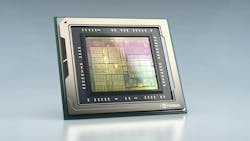Autonomous truck company Torc announced a collaboration with NVIDIA and Flex to develop a dedicated AI computer architecture that operates self-driving trucks.
Torc said that the partnership provided it with “a scalable high-performance production hardware and software platform” designed for the autonomous-ready Freightliner Cascadia. This dedicated platform helped the company complete its milestone closed-track trials at highway speeds last year.
See also: What’s your trucking AIQ?
What is in the architecture?
The platform includes hardware and software from NVIDIA and Flex.
Torc worked closely with NVIDIA to develop a multi-chip architecture that uses NVIDIA’s Drive AGX computing platform, including the company’s DRIVE Orin system-on-a-chip and DriveOS operating system. Torc worked with Flex to leverage its manufacturing capabilities and Jupiter compute design platform, a hardware and software system designed for AVs that also uses DRIVE Orin. Flex’s manufacturing capabilities will support Torc’s plans for scaled market entry in 2027.
“NVIDIA DRIVE AGX has been industry-proven in full production for automotive real-time applications at the edge. It delivers the high compute performance, low latency, and multi-sensor connectivity needed for Torc’s sophisticated autonomous trucking software, delivering robust perception, prediction, and planning for safe and reliable operation,” Rishi Dhall, VP of automotive at NVIDIA, said. “Torc is on a clear path to scalable production for its commercial launch in 2027 and working toward a seamless upgrade to NVIDIA DRIVE AGX with DRIVE Thor.”
See also: Kodiak goes commercial: Delivers first RoboTrucks to Atlas Energy’s private fleet
Torc said that NVIDIA’s and Flex’s solutions adhere to its stringent requirements for size, performance, cost, and reliability. The design is adaptable to new environments, including different hardware and sensor configurations, road conditions, lanes, hubs, operational rules, and more.
The brain of an autonomous vehicle
This computer architecture is the heart and brain of a self-driving truck’s “physical AI”—the total system of sensors, computers, and predictive algorithms that allow an autonomous vehicle to react to its surroundings. Physical AI allows the truck to make informed, autonomous decisions about lane changes, braking, obstacle avoidance, and more.
See also: Volvo’s VNL Autonomous fleet begins hauling freight for DHL in Texas
"With Daimler Truck’s autonomous-ready Freightliner Cascadias with in-built redundancy, our work with NVIDIA and Flex is already providing a stable and proven foundation for Torc's autonomous vehicle technology," Torc CEO Peter Vaughan Schmidt said. "By leveraging NVIDIA’s DRIVE AGX in-vehicle compute and DriveOS, along with Flex’s Jupiter compute platform, we are able to ensure a low-risk, high-confidence path to production that is able to seamlessly transition as NVIDIA’s and Flex’s solutions continue to evolve."
Torc is showcasing the capabilities of the joint solution on its demo truck at NVIDIA’s GTC event from March 17 to 21, 2025, in San Jose, California.
About the Author
Jeremy Wolfe
Editor
Editor Jeremy Wolfe joined the FleetOwner team in February 2024. He graduated from the University of Wisconsin-Stevens Point with majors in English and Philosophy. He previously served as Editor for Endeavor Business Media's Water Group publications.

